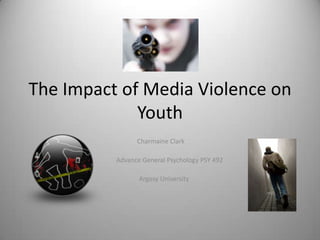
The Impact Of Media Violence On Youth Powerpoint
- 1. The Impact of Media Violence on Youth Charmaine Clark Advance General Psychology PSY 492 Argosy University
- 2. Introduction On June 24, 2008, six teenagers from Long Island, NY, launched a two hour long crime spree in which they committed a violent mugging and several break-ins and thefts before finally being caught after a carjacking attempt (Crowley 2008). Police authorities reported the teenagers claimed the crime was committed to replicate the actions of NikoBelic, the thuggish protagonist from the new video game ‘‘Grand Theft Auto IV.’’ ((Anderson et al.2003; US Surgeon General 1972, 2001). According to the American Medical Association (AMA), violence in the mass media, especially television, has reached such a high level that poses a hazard to the health of this country’s people (AMA, 1996). Observational learning and imitation is the determining factors of human behavior at a younger age. Therefore, the younger the person is, the more likely he or she is to react to observed behavior by imitating.
- 3. Research studies According to an article in Journal of Youth and Adolescence ( 2009), 820 youth participants in a study were sampled from populations of high school students (n = 430; 51.6% female; M age = 16.83 years, SD = .71; 45.9% racial/ ethnic minority) and incarcerated delinquents (n = 390; 26.4% female; M age = 15.55 years, SD = 1.53; 45.1% racial/ethnic minority) ( Cheng et at, 2004 ) In addition, parents and educators also shared information about the participating youth. All participants answered questionnaires that reflected on what their view was on television, types of computer activities and video game preferences. The study was based on the relationship between violent media use and aggressive behavior. Using criterion scores developed through cross-informant modeling of data from self, parent/guardian, and teacher/staff reports, observed that childhood and adolescent violent media preferences contributed significantly to the prediction of violence and general aggression from cumulative risk totals (Bushman and Huesmann’s, 2006). The results of the study showed media violence along with family (domestic violence or physical abuse) and community violence, increase violent behavior overtime in youth (Bushman and Huesmann’s, 2006)
- 4. Recommendations There are many approaches to educating parents and educators on the impact of media violence on children. One approach is media literacy education. Researchers have shown that this approach aids students in developing critical thinking and viewing skills and a necessary foundation for healthy decision making (Fuller, Damico, & Rogers, 2004; Kater, Rohwer, & Londre, 2002). Media literacy education has been effective in many areas; such as helping youth evaluate and rethink glamorous lifestyles shown in the media and Cantor’s ( 2000) curriculum on violent behavior and what’s its like to be a victim of crime (Fuller, Damico, & Rogers, 2004; Kater, Rohwer, & Londre, 2002). Despite this sense of awareness, research has also indicated that some students do not think through the complexities of the relations between media messages and their possible influence on thoughts, attitudes, and behaviors (Fuller et al., 2008). In addition, researchers have found that parental control over youth viewing can reduce violent confusion and promote awareness of media violence (Cantor, 2003).
- 5. Conclusion Television is a regular part of children’s lives, even before they learn to read. Children spend more hours in front of the television as they do in school or interacting with family (Macionis, 2006). For many years, parents and educators have been concern about the impact of media violence on children of all ages. The risk factors for aggressive behavior in childhood and adolescence are high risk factors and include, among others: exposure to violence and aggression in the community (Guerra et al. 2003; Schwartz and Proctor 2000).
- 6. References Anderson, C., Leonard, B., Edward, D., Huesmann, L., Johnson, D., Neil, M. (2003). The Influence of Media Violence on Youth. Psychological Science in the Public Interest: 2003-124; 3 Argosy University (2010) Research Methods. Library resource. Retrieved on June 6, 2010. Boxer, P., Huesmann, L., Bushman, B., O’Brien, M., & Moceri, D. (2009). The role of Media violence. 20(3), 79-96. doi:10.1027/1864-1105.20.3.79. Cantor, J., & Wilson, B. (2003). Media and Violence: Intervention Strategies for Reducing Aggression. Media Psychology, 5(4), 363-403. doi: 10.1207/S1532785XMEP0504_03. Cheng. T., Brenner, A., Wright, J. (2004). Children are Violent Television Viewing: Are Parents Monitoring? Pediatrics, 2004-07114:1 Hopf, W., Huber, G., & Weiß, R. (2008). Media violence and youth violence: A 2-year Journal of Youth and Adolescence, 38(3), 417-428. doi: 10.1007/s10964-008-9335-2. Longitudinal study. Journal of Media Psychology: Theories, Methods, and Applications, media preference in cumulative developmental risk for violence and general aggression. Strasburger, V., Wilson, B., & Jordan, A. (2009). Children, adolescents, and the media (2nd ed.). Thousand Oaks, CA US: Sage Publications, Inc. Retrieved from PsycINFO database. Tomkins, A. & Mark, A (1994) Children and Violence. Behavioral Science & the Law. 1994-0112; 1
Notes de l'éditeur
- Television can be a powerful influence in developing value systems and shaping behavior.
- The impact of TV violence may be immediately evident in the child's behavior or may surface years later.
- Parents can protect children from excessive TV violence in the following ways: Monitoring what children watch or have more family outings.
- Being a mother of nine sons, I monitor every aspect of what my children watch on television, who their friends are and weekly family meetings. At first my children were resistant to this idea, but eventually they respected th